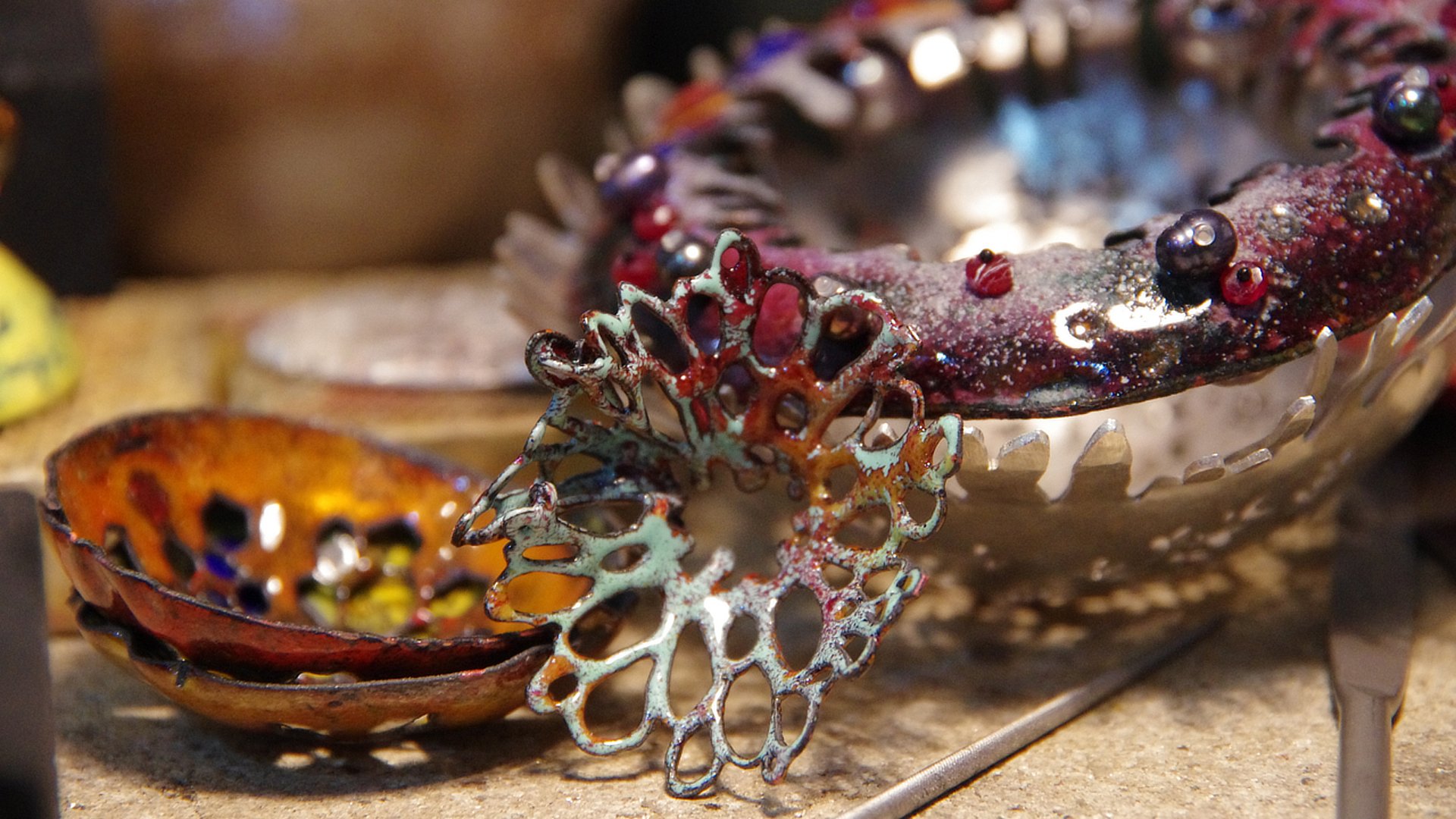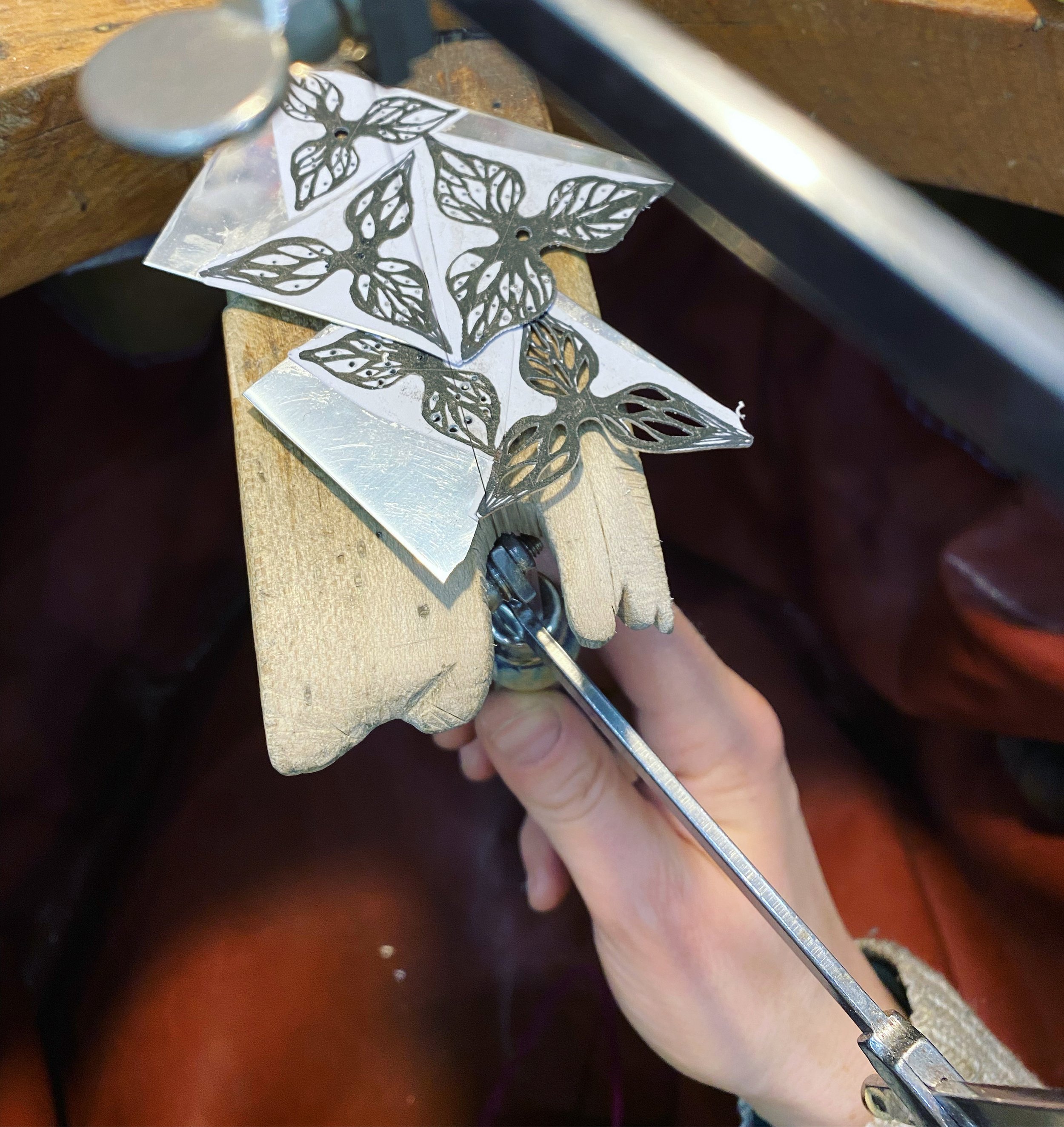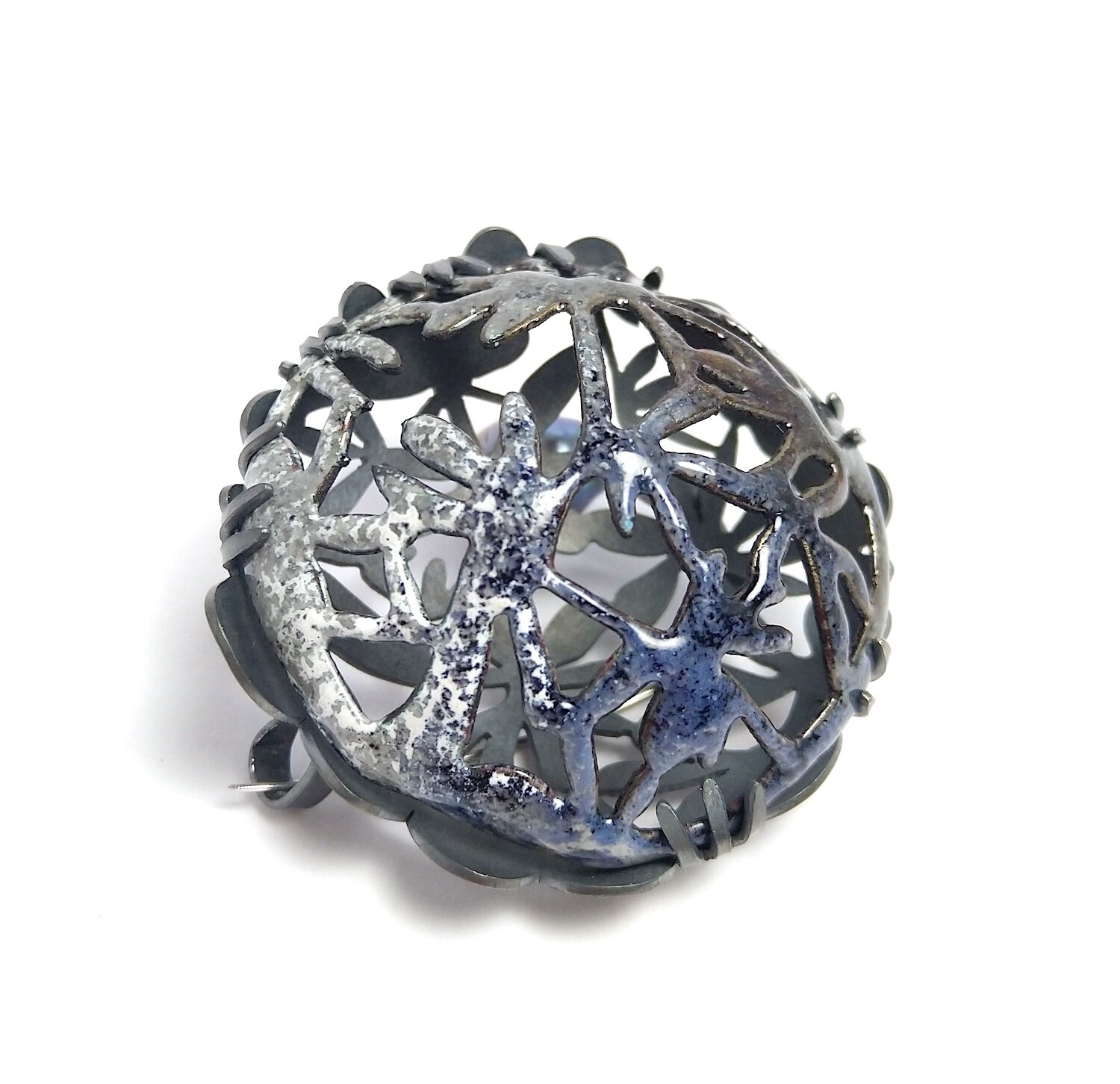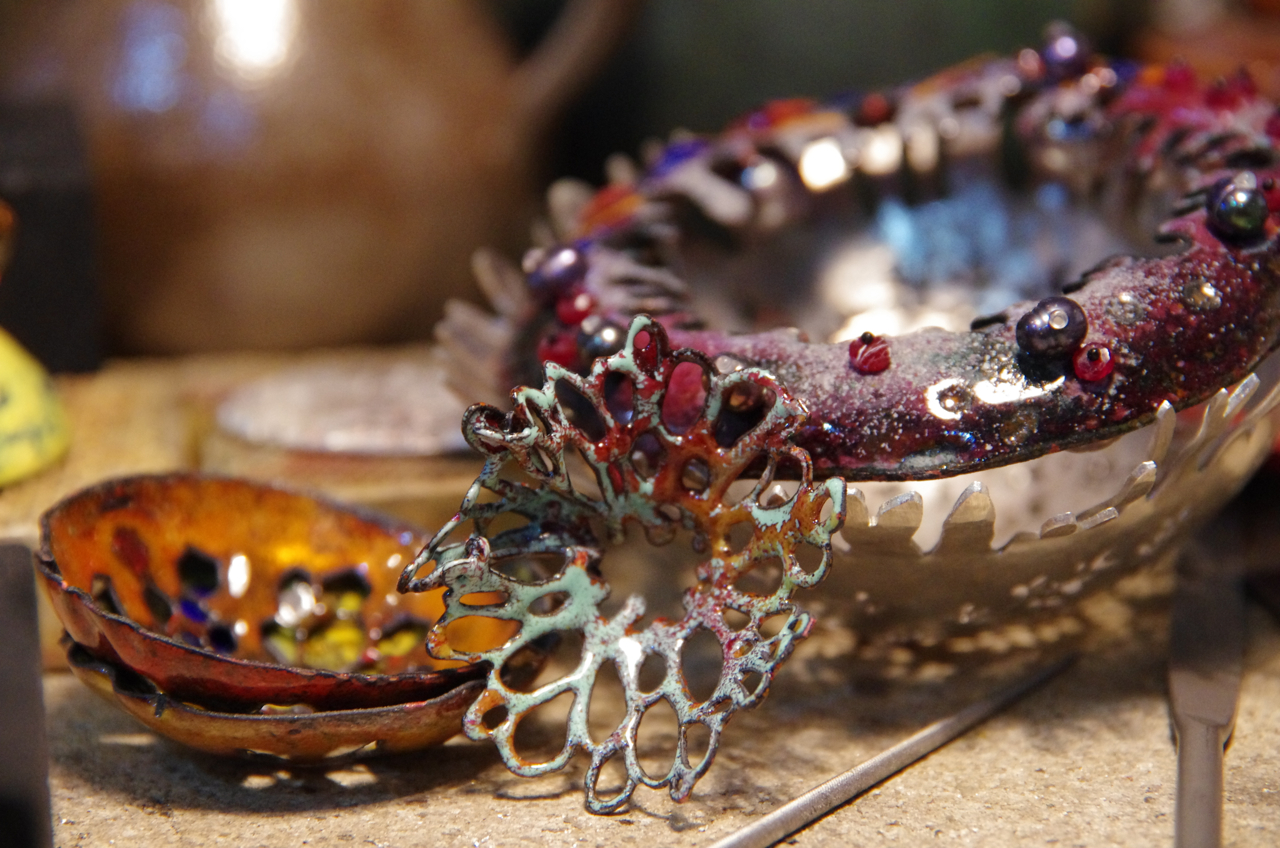
blog
Welcome to my blog. This is a place where I think out loud, show you what I’m up to in the studio, share impressions of inspiring events or everyday moments that moved me. Some entries are carefully curated essays, others are just a few thoughts, sometimes written in English and sometimes in German.
Featured posts

newest blog entries:
Stipendium "Junge Kunst und Neue Wege"
Im Sommer 2022 erhielt ich das Stipendium „Junge Kunst und Neue Wege“ des Bayerischen Staatsministeriums für Wissenschaft und Kunst, das mir erlaubte, mich einem größeren künstlerischen Projekt zu widmen. Im Rahmen dieses Stipendienprojekts habe ich die Kollektion SYBILLA entwickelt, die auf den Herbstmessen dieses Jahres zum ersten Mal präsentiert wird.
“JUNGE KUNST UND NEUE WEGE”
Arbeitsergebnisse eines Stipendiums des Bayerischen Staatsministeriums für Wissenschaft und Kunst
Auf Deutsch.
Im Sommer 2022 erhielt ich das Stipendium „Junge Kunst und Neue Wege“ des Bayerischen Staatsministeriums für Wissenschaft und Kunst, das mir erlaubte, mich einem größeren künstlerischen Projekt zu widmen. Im Rahmen dieses Stipendienprojekts habe ich die Kollektion SYBILLA entwickelt, die auf den Herbstmessen dieses Jahres zum ersten Mal präsentiert werden soll. In diesem Blogeintrag folgt eine detaillierte Beschreibungen sowie zahlreiche Abbildungen des Arbeitsprozesses. Mitunter sind weitere Einträge dieses Blogs unterverlinkt, die einige der recherchierten Themen zusätzlich aufgreifen und vertiefen.
Zielsetzung
Ich hatte mir in diesem Projekt zum Ziel gesetzt, eine besonders große und komplexe Arbeit in Angriff zu nehmen, bei der meine Arbeitsweise nicht vom potentiellen wirtschaftlichen Erfolg des Resultats beeinflusst sein sollte. Insbesondere wünschte ich mir Zeit und Mittel, umfangreicher mit verschiedenen Emaillefarben und -techniken experimentieren zu können. Ich wollte durch die Verbindung von tragbarem Schmuck und Installation Arbeiten schaffen, die die Abgrenzung zwischen Angewandter Kunst, Schmuck und Objekt verwischen. Inhaltlich wollte ich mich in das Thema (Paradies-)Gärten vertiefen und einzelne Symbole daraus gestalterisch in meiner Arbeit hervorheben. Die Arbeit sollte in einer Installation gipfeln, mehrschichtig und ganzheitlich wie ein Ökosystem gedacht.
Arbeitsprozess & UMSETZUNG
Die Umsetzung dieses Projekts begann zunächst mit vielen Zeichnungen (freiere Skizzen und lösungsorientierte Entwurfszeichnungen) und Recherchen. Ich beschäftigte mich intensiv mit Themen wie etwa historischen Paradiesvorstellungen, mit der mittelalterliche Suche nach dem Garten Eden, und dem neuzeitliche Interesse am Forschen und Sammeln von (aus westlicher Sicht) „exotischen“ Pflanzen, Tieren und kulturellen Objekten, die in botanischen Sammlungen, Florilegien und Wunderkammern präsentiert wurden. In dieser Zeit rutschte mein Fokus vom Granatapfel (mit dem ich mich schon einige Jahre intensiv beschäftigt hatte) als zentrales Symbol des Paradiesgartens, mehr in Richtung der ästhetisierten botanischen Zeichnungen des 17. und 18. Jahrhunderts im Allgemeinen. Speziell kristallisierte sich die stilisierte drei- oder sechsblättrige Blüte als Symbol der botanischen Neuankömmlinge in Europa für mich als gestalterisches Element heraus. Die achsensymmetrische Blüte ist eine visuelle Verschmelzung von Ordichee, Tulpe, Schwertlilie und anderen Zwiebelgewächsen mit farbenprächtiger und „exotischer“ Blütenfülle.
Dabei fasziniert mich speziell der fließende Übergang zwischen Imagination und naturwissenschaftlicher Beobachtung in den botanischen Illustrationen des 17. und 18. Jahrhunderts. Oft sind in Zeichnungen dieser Zeit komplette Ökosysteme dargestellt, wobei die Fantasie Wissenslücken gekonnt ausfüllt oder Beobachtetes frei ausschmückt. Beispielsweise werden Pflanzen und Insekten gemeinsam abgebildet, die in Wirklichkeit keine spezielle Beziehung zueinander haben. Auch werden Pflanzen gleichzeitig blühend, Früchte tragend und Samen formend dargestellt – ein biologisch unmöglicher, mythisch-paradiesischer Zustand also (und gestalterisch von großem Interesse). Komposition und Ästhetisierung sind dabei sehr wichtig. Eine Künstlerin und Naturforscherin, deren Arbeiten hier ganz besonders hervorstechen, ist Maria Sybilla Merian (1647-1717). Meine Kollektion SYBILLA, die hier in diesem Stipendienprojekt ihren Anfang nimmt, ist nach ihr benannt.
Dem Zeichnen, Skizzieren und Lesen folgten zahlreiche Emaille-Experimente. Ich konnte durch das erhaltene Stipendium eine große Menge neuer Emaillefarben und Zubehör sowie Kupfer und Silber zum Emaillieren erwerben. Aus den neuen Farben fertigte ich als erstes Farbproben, die dazu dienen, die Charaktereigenschaften der Farbe zu testen und als Farb-Referenz für zukünftige Arbeiten zur Verfügung zu haben. Konkret bedeutet das also, dass die pulverisierten Emaillefarben gewaschen, auf kleine Kupfer- oder Silberplättchen aufgetragen und anschließend aufgebrannt und katalogisiert werden müssen. Auf der Suche nach spannenden Kombinationen kombinierte ich in manchen Experimenten mehrere Farben in Lagen übereinander.
Experimente dieser Art sind immer sehr arbeitsintensiv, aber nur so sind auch zufällige und neue Entdeckungen möglich. Da die zu emaillierenden Elemente meiner Kunstobjekte ebenfalls sehr zeitaufwendig goldschmiedisch gefertigt werden (ausnahmslos von Hand ausgesägt, aufgetieft, gelötet, konstruiert), möchte ich natürlich vorher sicher sein, mit welchen Farbkombinationen die gewünschten Effekte erzielt werden können. Trotzdem ist der Emailleprozess selbst von vielen Variablen beeinflusst und das Arbeitsergebnis oft unvorhersehbar. Genau dieses Zusammenspiel von Planung und Spontanität macht für mich den Reiz am Emaillieren aus: Dem Arbeitsprozess wohnt für mich eine Magie inne, die es hervorzulocken gilt. Das funktioniert nicht mit Wille und Gewalt, sondern nur durch Zeit und Zuwendung, Geduld, Demut, und dem Wissen, dass dieser Emailleprozess mir ein Tor zu etwas Größerem, Mitreißenden öffnen kann.
Im Herbst 2022 hatte ich einen ersten großen Halsschmuck der Kollektion SYBILLA entwickelt: Ein barock anmutendes, opulentes, bordeauxrot emailliertes Collier aus archetypischen dreiblättrigen Blüten, teils durchbrochen, wie von Insekten zerfressen, die mit mehrsträngigen Granatketten verbunden sind. Die dreifach gespiegelte achsensymmetrische Blüte als Archetyp der „exotischen“, aus fernen Ländern importierten Blume steht im Zentrum des Colliers. Gefasst sind die Blüten in weitere, noch stärker zerfressene Blüten aus patiniertem Silber. Es ist ein Reigen aus Ordnung und Chaos, aus Schönheit und Zerfall, aus Fressen und Gefressenwerden.
Ein zweiter Halsschmuck ist aktuell im Entstehen, sowie parallel mehrere kleinere Stücke wie Statement-Ohrringe und Tischobjekte. SYBILLA II ist noch ausladender, mit zart changierenden rosa-schwarz-opalweißen Blütenblättern, die mit Süßwasserperlen zu einer opulenten Komposition zusammengefügt werden sollen. Dieses Stück wird in ein größeres Aquarellkunstwerk eingefügt, sodass die emaillierte Blütenelemente eine Verwischung zwischen zweidimensionalen und dreidimensionalen Darstellungen, zwischen Objekt, Angewandter Kunst und Schmuck bewirken.
Pandemie, Stipendium & Weiterentwicklung
Die Corona-Pandemie bedeutete für mich, wie für so viele im Kreativbereich, einen großen Einschnitt in meinen Arbeitsprozess. Mir fehlte es an Zeit, Freiraum und Material, mich an etwas Größeres zu wagen, das nicht zwangsläufig mit wirtschaftlichen Erfolgen verknüpft war. Diese Freiheit hat mir nun das Stipendienprogramm „Junge Kunst und Neue Wege“ geschenkt.
Ich konnte mit Hilfe des Stipendiums eine ganz neue Kollektion zu entwickeln. Die hier abgebildeten Arbeiten sind nur der Anfang; in den nachfolgenden Monaten sind noch weitere Arbeiten dieser Kollektion entstanden und werden kontinuierlich weiterentwickelt - sowohl kleinere Stücke und ausladende Statement-Colliers, als auch multidisziplinäre Installationen. Hier dazu einige Beispiele:
Poetic Fantasy on Lost Gardens and Being Human
I miss my garden.
The last garden I had was back in 2032, that narrow walled garden at the back of our apartment. I remember walking barefoot down the stone steps, I remember birds hidden behind layers of foliage, and the taste of early summer radishes. I miss being separate but still part of the world in that tranquil microcosm.
Below is a poetic meandering of thoughts, written as an artist statement to accompany my newest series of brooches titles “Memorabilia”.
Memorabilia I. 2020. Brooch. Sterling silver (blackened), enamel on copper, steel pin, black baroque pearl. Hand sawn, constructed, enamelled.
I miss my garden.
The last garden I had was back in 2032, that narrow walled garden at the back of our apartment. I remember walking barefoot down the broad flagstones, I remember birds hidden behind layers of foliage, and the taste of early summer radishes. I miss being separate but still part of the world in that tranquil microcosm.
My garden was an inner sanctum that freed something in my chest, that carved out patterns of meaning for my life and the lives I touched. It allowed me to face the outside with courage. It was beauty, and perhaps unnecessary, although its unnecessariness made it an utter necessity in itself. It was order, and it was chaos, it was decay and love and frilliness, it was a glimpse of a splendid room that allows you to imagine the entire palace; it was a throbbing, ever-growing metaphor for our most precious human skill - the use of our imagination.
It was a space where small gestures mattered, where our humanness was reflected in a personal pantheon of fragile dreams: the furriness of moss on stone, in the twisted branch of something dry, in the post-rain puddles on the garden path.
Now that almost nothing of that mythical space remains, now that we have destroyed and scorched, wallowing in dispassionate inaction while our capacity for kindness shrivelled, while we waited, we have lost the language of imagining meaning.
We remind ourselves of our humanity in the memories that remain, held together in the blackened bone reliquaries of that sacred garden.
Memorabilia II. 2020. Brooch. Sterling silver (blackened), enamel on copper, steel pin, black baroque pearl. Hand sawn, constructed, enamelled.
Memorabilia III. 2020. Brooch. Sterling silver (blackened), enamel on silver, steel pin, black baroque pearl. Hand sawn, constructed, enamelled.
Enamelling in Circles
A collection of enamelled tidbits on my jewellery bench.
I’m enamelling. The kiln has heated up properly by now, and I start unpacking my enamels – little multi-coloured medicine bottles filled with glass powders in rows at the edge of my working surface. For a few moments, I simply hover over the colours, compare the different hues, delight in the subtle differences. Colours govern my life. With enamels, each one has a different personality – it is either transparent, so you can see the metal underneath after firing it, or opaque; it can be smooth or grainy, some have a high melting temperature, some a low one, some break up into bits and dissolve into other colours, some get miniature green cracks around the edges when heated a few times.
If you don’t treat them according to their personalities, they misbehave: they splinter after firing while cooling down, flake off the metal surface, become cloudy, or burn into an ugly colourless dead-looking surface.
Every action of this process of firing glass onto metal has become a strange ritual. Mixing glue for concave surfaces. Laying out brushes, spatulas, small ceramic bowls. Sifting powders onto metal. The careful, deliberate lifting and placing of the powdered pieces onto metal tripods, rickety with use and coated with stray enamel blobs. And then, opening that furnace of a kiln at 800 degrees Celsius, being bathed in a heat wave that leaves my face tingling and hot. Opening, closing, sifting, waiting, cleaning off firescale, sifting. Balancing, opening, closing, waiting, sifting, opening closing. It’s like a dance and I become entranced in it. After some time, my face becomes glowing hot and it must be bright scarlet by now. I forget about my surroundings, surrender myself willingly to the power of the enamels. Then, and only then, can they unfold their true beauty – the moment I stop trying to master them, and let them lead me. They fuse, run, melt, burn, shimmer into spectacular patterns that no-one could have foreseen. And I am left deeply satisfied by the thought that this individual pattern that just happened, right there, can never ever be reproduced again. If this is not magic, I wonder what is. To me, enamelling really isn’t a science, even though it’s a scientific process.
A kiln, glowing hot.
First layer done - one of many.
It’s no surprise that enamelling has become my favourite jewellery-making technique, considering the significance of colour in my life. Colours have their own designated meaning in my world, every cypher and every letter has its own colour in my mind, large numbers become colour sequences. However, my fascination with enamels lies deeper than just its appearance. The ancient history of the enamelling process, almost alchemical in nature before the advent of electricity, intrigues me just as much. Jewellers have used enamel for its intrinsic qualities of brightness, hardness and durability, also taking advantage of its elusiveness and mutability to suggest, among other things, precious stones, filigree inlay work, stained glass and even painting.
Although it is unclear how long enamels have existed, it is likely that they were developed in Egypt. Masters of working with fire, the Egyptians invented glass. Around the third millennium BCE they perfected the fabrication of the earliest known synthetic pigment, a double silicate of copper and calcium that compensated for the lack of affordable natural blue pigments. This new blue pigment, called Alexandrian blue, could be used in paints, inks, glass and, mixed with sodic alkaline salts, form a variety of spectacular blue faience glazes.
The development of early enamelling techniques is documented by two major sources: the Benedictine monk Theophilus whose 12th century treatise on Medieval art techniques explained some of the contemporary enamelling processes, as well as the notorious 16th century Italian jeweller Benvenuto Cellini, whose Trattato dell’Oreficeria includes detailed, step-by-step instructions on enamelling. Cellini describes the preparation of enamels as a laborious process of hand-grinding chunks of coloured, transparent glass and then washing the powder with filtered water to remove dust and impurities. Both authors describe the same kind of furnace – a type of upside-down earthenware vessel inside a protective perforated iron container, placed into a roaring fire and completely covered with hot coals. This challenging and time-consuming process can only be marvelled at, since each enamelled piece required numerous firings and timing thereof had to be impeccable.
Since enamelling was depended on pigments for its vivid colours, it is also clearly linked to alchemical practices. Much of the medieval research in chemistry was carried out by alchemists, whose laboratories and methods were described in an arcane language, often laden with metaphor. Their reluctantly and cryptically published discoveries show a wealth of experimentation focused on the transmutation of substances. Because of this interest in the mutable properties of metals, as well as their work with processes of extraction and distillation of solids and liquids, alchemists stimulated a renaissance in the production of colour pigments: they created vermilion red from sulphur and mercury, yellow by adding sulphur to arsenic, and a gold pigment by mixing sulphur, tin and mercury.
Cloisonné enamel: little pockets of colour, framed by silver or gold borders. These are cuff links I made in enamel and white gold.
Apart from this obvious, historical link, enamelling also evokes the language of alchemy: born from fire, the pale powders transform into brilliant, vitreous colour; the process is technical yet also deeply intuitive, experimental and somehow mysterious. The exact moment of perfect, glossy fusion relies on timing – in my case never governed by a neat and orderly time scale, but rather an enigmatic internal clock that relies on ‘gut feeling’ to gauge when a piece is ready. This gloriously ‘messy’, spontaneous side of the enamelling process subverts the scientific, grid-like standards that are superimposed on almost every part of modern routine.
Pale powders transform into bright, glossy glazes.
Sources:
Delamare, F & Guineau, B. 2006. Colour – Making and Using Dyes and Pigments.London: Thames & Hudson.
Strosahl, J. P. 1981. A Manual of Cloisonné & Champlevé Enamelling. New York: Charles Scribner’s Sons.
Photographs: Nicola Fouché and Nora Kovats.
Sifting pink enamel powder onto a copper earring segment.
Vlamlek
Vlamlek. 2019. Enamel, copper, sterling silver, nylon, silk, lapis lazuli, agate.
Vlamlek starts with a story about an old Cape Dutch farmhouse surrounded by Strelitzias, planted there to symbolize a protective ring of fire that was meant to shield its inhabitants from ‘foreign’ and harmful influences. This thought of barriers, of keeping out and letting in selectively, the urge to delineate the homestead, is immensely powerful and can be traced back eons in different cultures. I found myself playing with the shape and symbolism of the Strelitzia, half flame, half flower.
The Strelitzia is a peculiar flower, indigenous to South Africa yet ‘discovered’ by a British botanist and named in 1773 by Sir Joseph Banks (curator of the Royal Botanical Gardens at Kew) somewhat randomly in honour of Queen Charlotte, the Duchess of Mecklenburg-Strelitz. To me, this flower epitomizes how South Africans – human, animal and botanical - have become a tangle of complex influences: the Western influence is palpable everywhere, European laws and societal norms and lately a newer but equally visible American influence, yet in between so distinctly African too, with uniquely developed customs and values, a flavour of flame and the primordial power of the earth.
Fire – heating metal and enamelling – is my language of creating. I’m becoming more experimental in my technique, savouring the burns and scars of this haphazard process. Enamel dust thrown at the metal almost violently, layer upon layer, then ground off again, scraped, colours bleeding into one another, bruised, fired over again until I achieve that mottled brightness fringed with burn. I love the immediacy of this process; I breathe it when I work. Yet it cannot be completely impulsive, there are natural laws to be obeyed, melting temperatures and properties of metals to consider, the language of the colours to respect. Enamelling is the marriage of something wild and untameable with an ordered, measured, law-abiding other.
Vlamlek is my attempt to show how, in my mind, seemingly contradictory elements have to be embraced, danced with and smelted around each other, in order to stay sane in a world where my European-South-African identity seems to tear itself apart at times.
Vlamlek (Detail).









































This summer, I have taken some time for deep thought to reflect on my most important beliefs underpinning my creative practice. I think of these nine concepts below as directional pointers for my inner creative compass. This is a deeply personal navigational tool for whenever the weather gets a little rough and stormy, and clear vision is impaired.